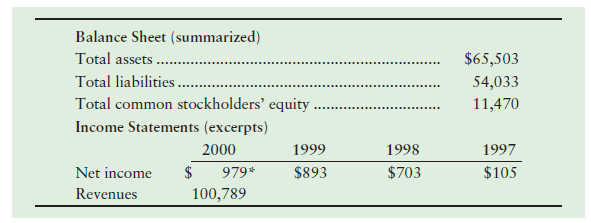In 2002, Enron Corporation filed for Chapter 11 bankruptcy protection, shocking the business community: How could a
Question:
In 2002, Enron Corporation filed for Chapter 11 bankruptcy protection, shocking the business community: How could a company so large and successful go bankrupt? This case explores the causes and the effects of Enron’s bankruptcy.
At December 31, 2000, and for the four years ended on that date, Enron reported the following (amounts in millions):

Unknown to investors and lenders, Enron also controlled hundreds of partnerships that owed vast amounts of money. These special-purpose entities (SPEs) did not appear on the Enron financial statements. Assume that the SPEs’ assets totaled $7,000 million and their liabilities stood at $6,900 million; assume a 10% interest rate on these liabilities. During the four-year period up to December 31, 2000, Enron’s stock price shot up from $17.50 to $90.56. Enron used its escalating stock price to finance the purchase of the SPEs by guaranteeing lenders that Enron would give them Enron stock if the SPEs could not pay their loans.
In 2001, the SEC launched an investigation into Enron’s accounting practices. It was alleged that Enron should have been including the SPEs in its financial statements all along. Enron then restated net income for the years up to 2000, wiping out nearly $600 million of total net income (and total assets) for this four-year period. Assume that $300 million of this loss applied to 2000. Enron’s stock price tumbled, and the guarantees to the SPEs’ lenders added millions to Enron’s liabilities (assume the full amount of the SPEs’ debt was included). To make matters worse, the assets of the SPEs lost much of their value; assume that their market value is only $500 million.
Requirements
1. Compute the debt ratio that Enron reported at the end of 2000. By using the DuPont Model, compute Enron’s return on total assets (ROA) for 2000. For this purpose, use only total assets at the end of 2000, rather than the average of 1999 and 2000.
2. Compute Enron’s leverage ratio for 2000. Use total assets and total stockholders’ equity at the end of 2000. Now compute Enron’s return on equity (ROE) by multiplying the ROA computed in Part 1 by the leverage ratio. Can you see anything unusual in these ratios that might have caused you to question them? Why or why not?
3. Add the asset and liability information about the SPEs to the reported amounts provided in the table. Recompute all ratios after including the SPEs in Enron’s financial statements. Also compute Enron’s times-interest-earned ratio both ways for 2000. Assume that the changes to Enron’s financial position occurred during 2000.
4. Why does it appear that Enron failed to include the SPEs in its financial statements? How do you view Enron after including the SPEs in the company’s financial statements? (Challenge)
Financial StatementsFinancial statements are the standardized formats to present the financial information related to a business or an organization for its users. Financial statements contain the historical information as well as current period’s financial... Corporation
A Corporation is a legal form of business that is separate from its owner. In other words, a corporation is a business or organization formed by a group of people, and its right and liabilities separate from those of the individuals involved. It may...
Step by Step Answer:

Financial Accounting
ISBN: 978-0134725987
12th edition
Authors: C. William Thomas, Wendy M. Tietz, Walter T. Harrison Jr.





